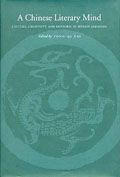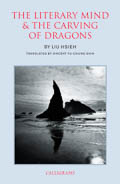start > Klassieke teksten > Personen/auteurs > auteur
Liu Xie 劉勰
Liu Xie 劉勰 (ca. 465–522)
Liu Xie, courtesy name Yanhe (彦和), was a Chinese monk, politician, and writer. He was the author of China's greatest work of literary aesthetics, The Literary Mind and the Carving of Dragons (文心雕龍). His biography is included in the Liangshu.(wiki)
It is generally assumed that Liu Xie, styled Yanhe 彥和, was born between 460 and 480 in Jingkou 足口 near Jiankang (present Nanjing) into a distinguished but impoverished family whose members had formerly served in high ranks. The family may have been distantly related to the reigning house of the Han dynasty. Orphaned at an early age, Liu was devoted to learning. He did not marry, but It is generally assumed that Liu Xie, styled Yanhe 彥和,was born between 460 and 480 in Jingkou 足口 near Jiankang (present Nanjing) into a distinguished but impoverished family whose members had formerly served in high ranks. The family may have been distantly related to the reigning house of the Han dynasty. Orphaned at an early age, Liu was devoted to learning. He did not marry, but depended on the eminent Buddhist monk Sengyou 僧祐 (445-518), who edited such important works as the Chu sanzang ji ji 出三藏記集 (Collected notes on the production of the Tripitika) and Hongming ji, q.v. Liu stayed with Sengyou at the Dinglin 定林 Temple on Mount Zhong 鐘 north of Jiankang for more than a decade, assisting him with the cataloging and collation of Buddhist scriptures. There is no consensus as to whether Liu was still an impressionable boy when he entered the temple or was already a young man with a solid Confucian education.
(...)
After the founding of the Liang dynasty (502), Liu was appointed to various minor offices at court and beyond. The most noteworthy of these positions was interpreter-clerk of the Eastern Palace (donggong tongshi sheren 東宫通事舍人) in the service of heir-apparent Xiao Tong 蕭 統 (Zhaoming taizi 昭明太子;501- 531), sometime during the early Liang and probably between 506 and 513. The prince enjoyed Liu Xie's company and may have been influenced by him in the compilation of his Wen xuan, q.v.
(...)
The collected writings mentioned in Liu Xie's Liang shu biography were lost by the Tang dynasty. Apart from the Wenxin diaolong, only two other texts have survived to this day. One is a stele inscription (a genre in which Liu reportedly excelled) and is titled "Liang Jian'an wang zao Shanshan Shicheng si shixiang bei" 梁建安王造刺山石城寺石像碑 (Epitaph on the stone statue [of Maitreya] erected by the Liang Prince of Jian'an at Shicheng Temple on Mount Shan). The Prince of Jian'an was Xiao Wei 蕭偉 (476-533), who erected the statue in the year 516. The other text is a Buddhist apologetic, titled "Mie huo lu n "減惑論(Disquisition on the elimination of doubts). It remains an open question whether Liu Xie authored the politico-philosophical text Liuzi xinlun (Master Liu's new disquisitions). (Antje Richter 2014 p389-394)
Klassieke teksten
- schrijver van de Wenxin diaolong (The Literary Mind: Dragon-Carvings)Literatuur
Boeken 1 tot 3 van de 3
Cai, Zong-qi, redactie (2001). A Chinese Literary Mind: Culture, Creativity, and Rhetoric in Wenxin Dialong. Stanford University Press. *
ISBN10: 0804736189
Meer informatie...
Shih, Vincent Yu-chung (1959). The literary mind and the carving of dragons. Columbia University Press. *
herziene editie 1983 en opnieuw herziene editie 2015
ISBN13: 978-9629965853
Ook online.
Meer informatie...
Tian, Xiaofei (2007). Beacon Fire and Shooting Star: The Literary Culture of the Liang (502–557). Harvard University Asia Center. *
ISBN13: 978-0674026025
Meer informatie...
Boeken 1 tot 3 van de 3



